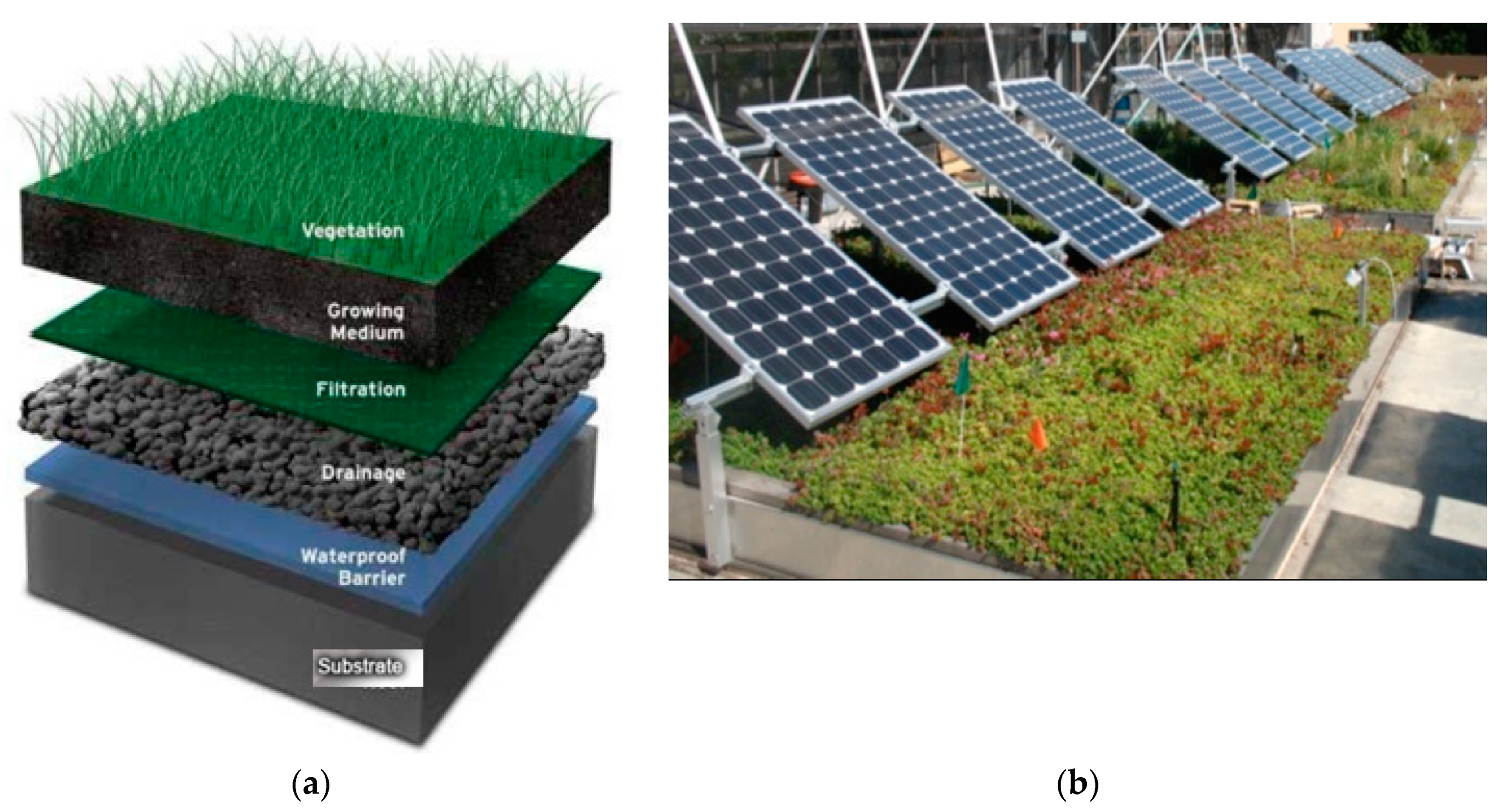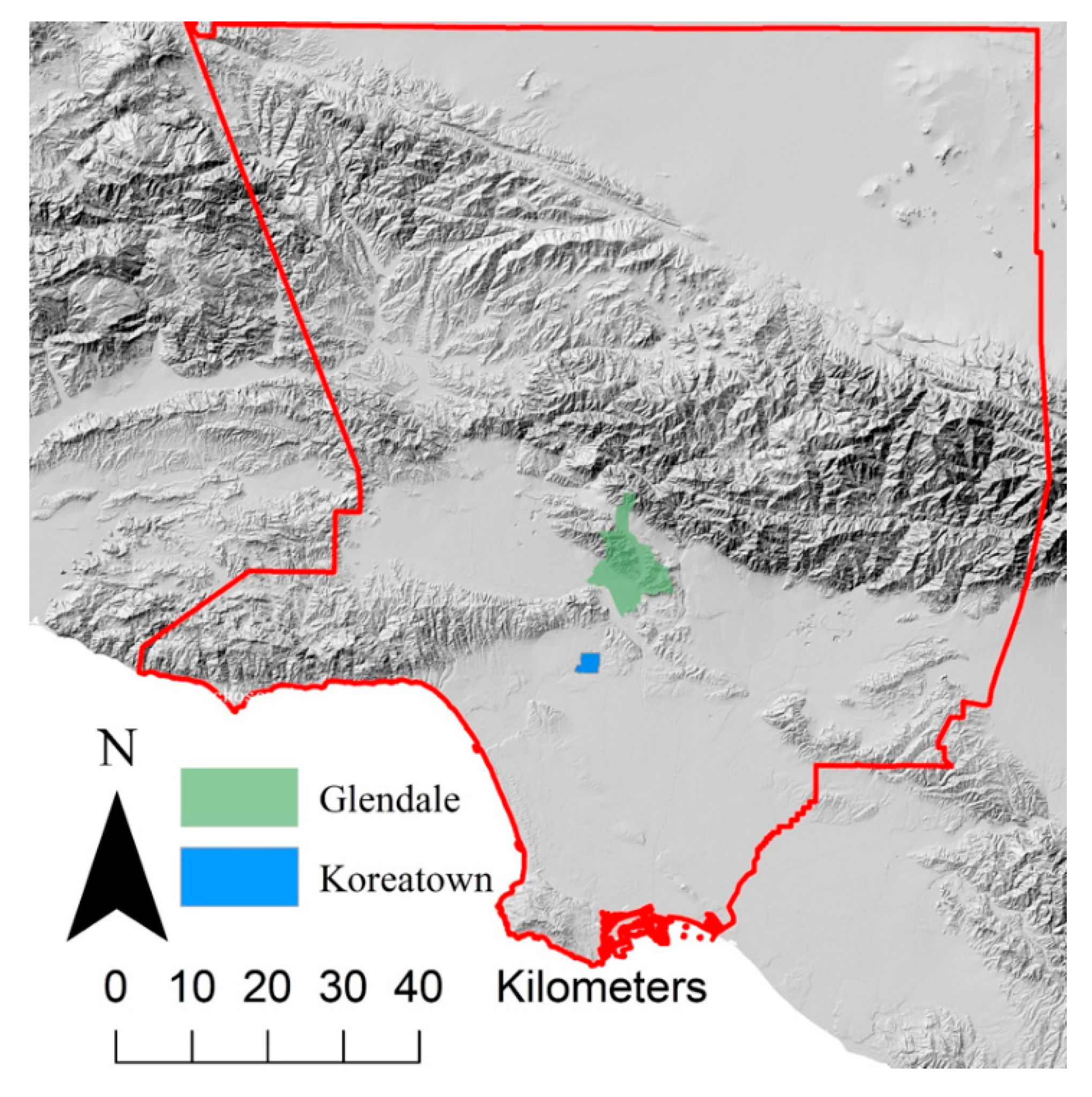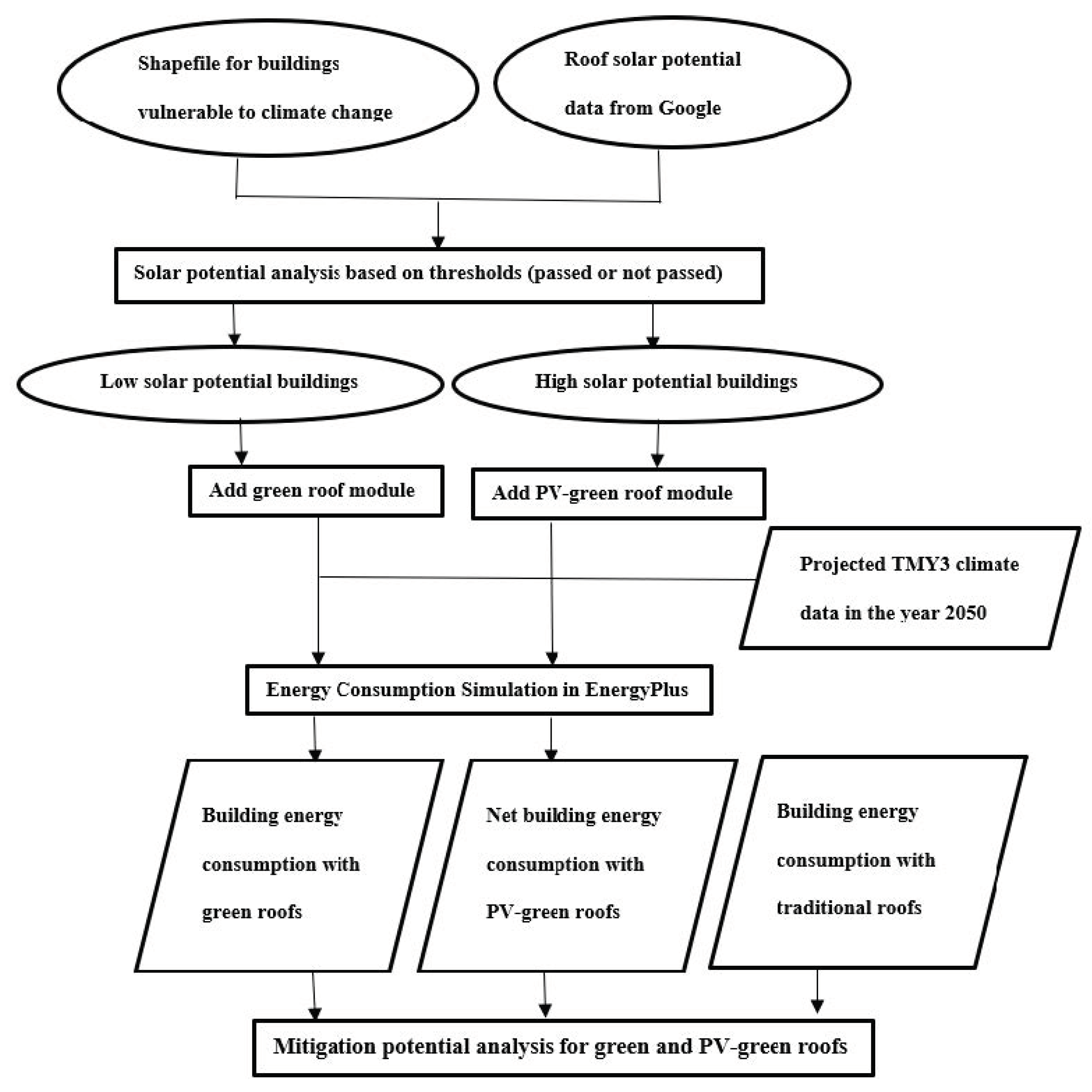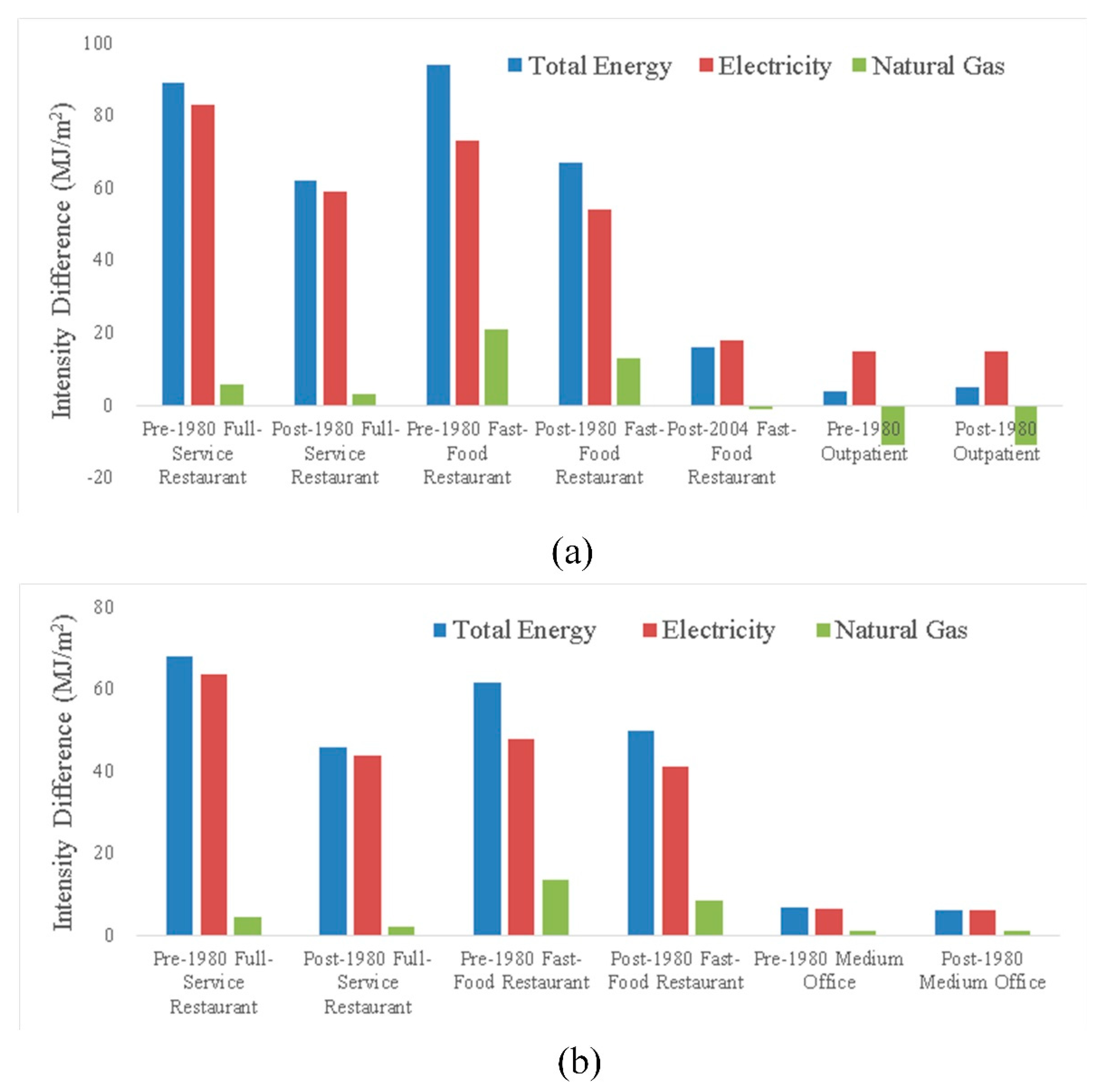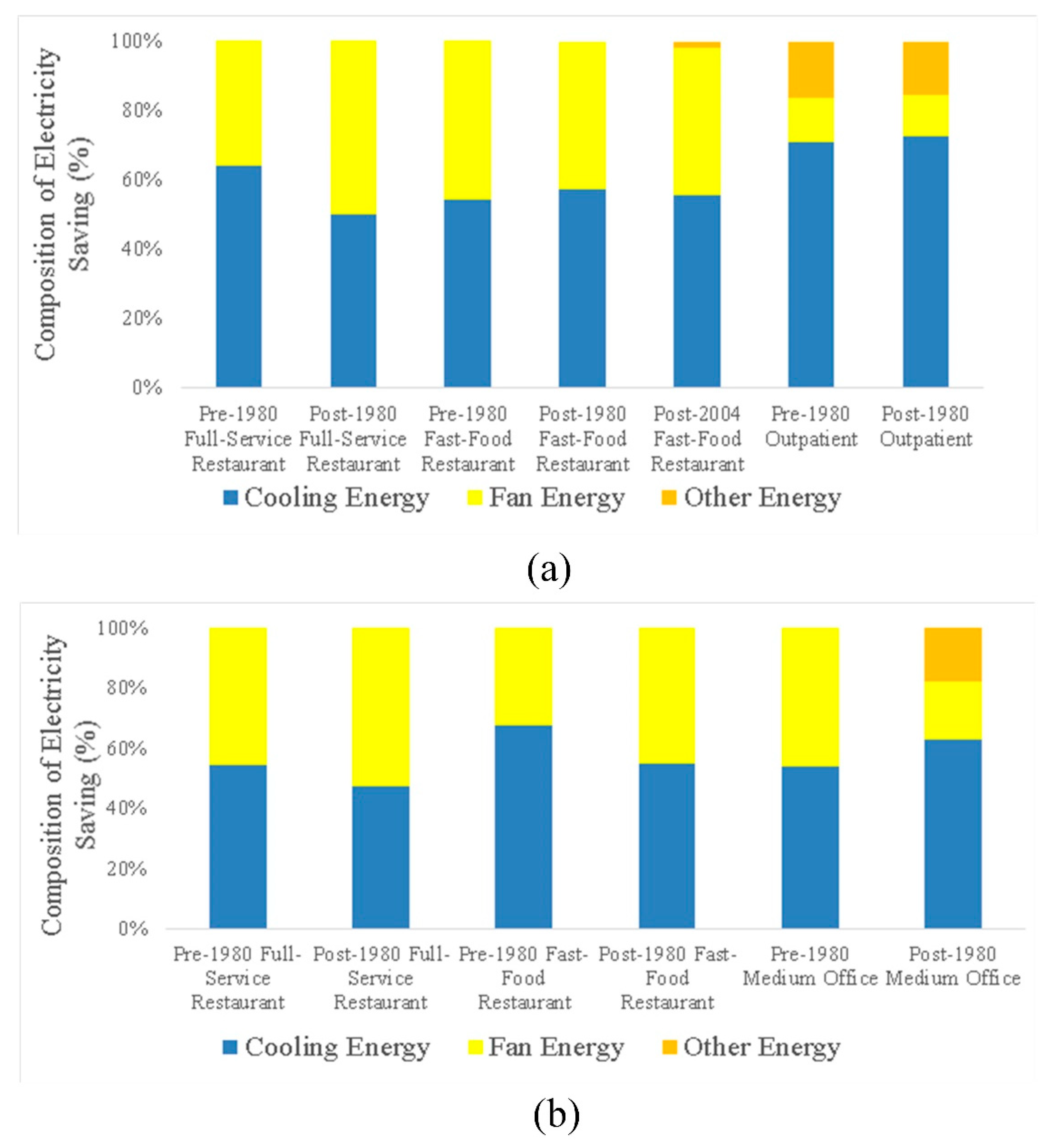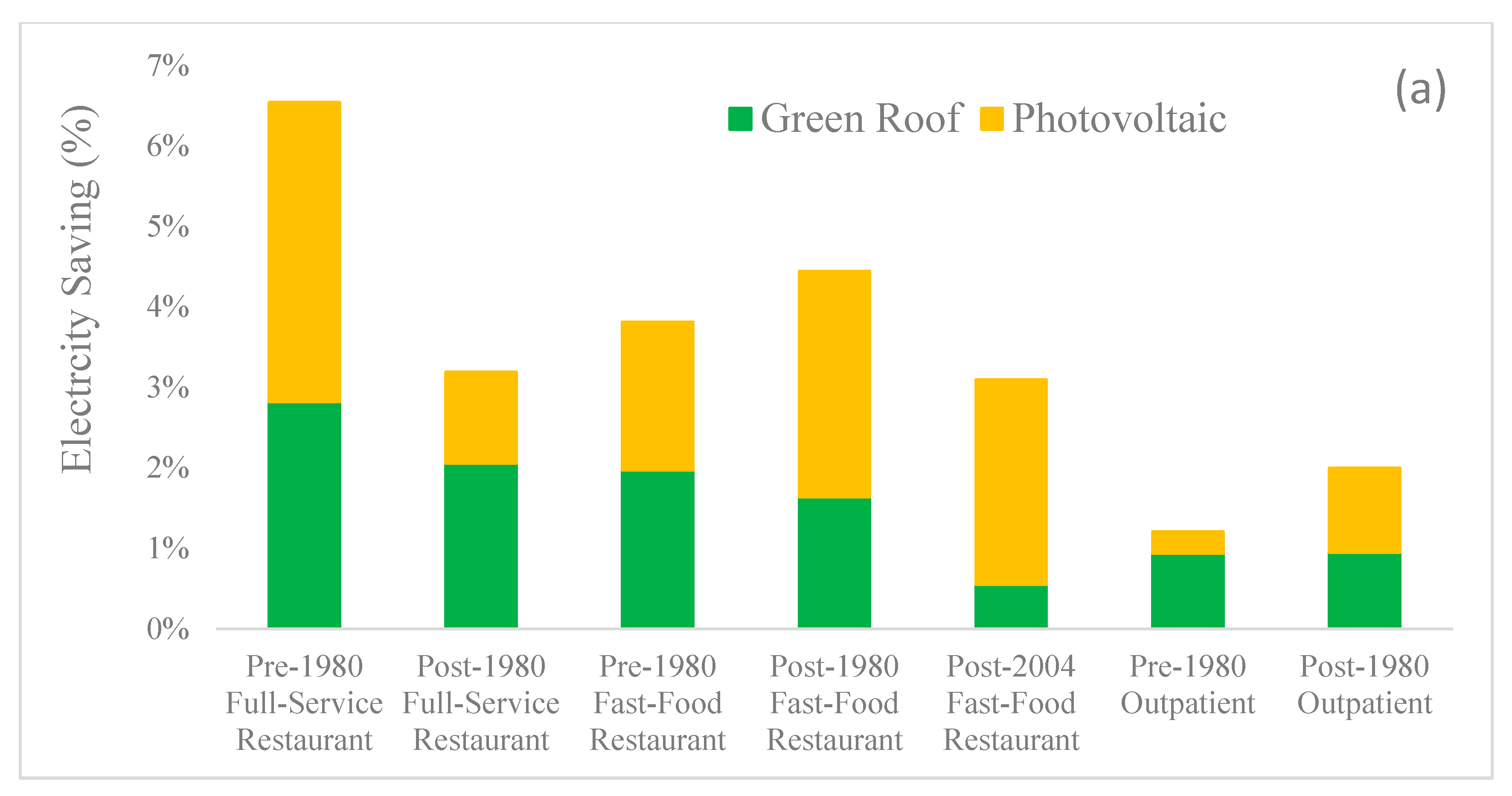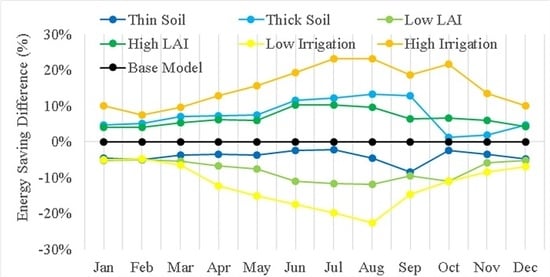1. Introduction
Building energy consumption is the largest contributor to anthropogenic heat in many cities [
1,
2,
3], which is demonstrated to be a major contributor to urban heat island (UHI) formation [
4,
5,
6]. Demands for space heating and cooling in buildings, which account for approximately 50% of total building energy consumption [
7,
8], can be significantly affected by global warming [
9,
10,
11]. The increase in annual building energy usage will cause higher carbon emission because traditional fossil fuels are still the major electricity production resources that are used for cooling in buildings [
11].
Policymakers need to make efforts to reduce the energy consumptions in new and existing buildings under the context of climate change [
11,
12,
13]. One important direction is to apply mitigation strategies such as urban greening and increasing renewable energy sources to ease environmental problems, especially the UHI caused by urbanization. Research on urban greening strategies mainly includes tree planting [
14,
15,
16], façade greening [
17,
18], and roof greening [
19,
20,
21,
22]. In high-density urban commercial areas, street trees provide limited contributions to UHI mitigation because their canopies cannot provide shade for buildings taller than the trees themselves. Moreover, there are ground surface area limitations for ground-level tree planting [
19]. Therefore, green roofs and rooftop solar photovoltaic (PV) systems research have become popular [
12,
23,
24]. A green roof is a roof with suitable growing media and vegetation, which have become popular as a potential alternative means for re-establishing the connection between nature and a city [
25], enhancement of the aesthetic appearance of buildings [
26], and improvement of environmental quality [
19]. Modern green roofs are generally consisting of many layers, such as vegetation, growing medium, filtration, drainage, waterproof membrane, and substrate [
19] (
Figure 1a). These layers enhance the insulation capacity of a traditional roof by blocking the heat transfer from solar radiation, which is the main heat source in the buildings. Moreover, the evapotranspiration of vegetation can also create a cooling effect in the building, as the vegetations absorb the solar heat and evaporate water through their biological functions [
19]. Green roofs can be classified into intensive and extensive based on the thickness of the substrate layer and the vegetation species planted. Extensive green roofs have thinner substrate layers (up to 15 cm) and limited types of grasses planted on top [
27]. The intensive green roofs, which are also called roof gardens, have thicker substrate layers and are planted with taller vegetation, such as shrubs and small trees [
27].
Existing studies have examined the performance of green roofs in building indoor temperature reduction and energy consumption savings by considering various factors, including climate [
19,
28,
29], green roof types [
19,
30], spatial coverage [
19], maintenance status [
27,
29], building density [
27], and building height [
30]. The majority of existing studies simulated the performance of green roofs using an energy balance model of vegetated rooftops integrated into EnergyPlus software, which was developed by Sailor [
20]. Morakinyo et al. suggested that during the daytime, the cooling effect of green roofs was more apparent in the full-intensive type under all climate conditions [
19]. However, the extensive green roof types were demonstrated to have better UHI mitigation potential due to less solar heat absorption during the daytime. Heusinger et al. discovered that maintenance, such as irrigation, played a vital role in the performance of green roofs [
27]. In recent years, a few studies [
18,
31,
32,
33,
34,
35,
36,
37,
38,
39,
40] have suggested the integration of green roofs with a solar PV system. In a typical PV-green roof system, PV panels are mounted above the layer of green roof with reasonable distances and angles (
Figure 1b), which allows growing room for the vegetation without blocking light to the solar cells. The potential symbiotic relationship between PV panels and green roofs had been proved by many studies [
31,
35,
36,
37,
38,
39,
40], which suggested that integrating PV with green roofs can provide reciprocal benefits to both PV electrical production and green roof communities [
36]. However, climate conditions, types of vegetation species on green roofs, and the installation heights of PV panels can affect this symbiotic relationship. Chemisana and Lamnatou stated that vegetation provided a cooling effect on the PV systems, which can lead to an increase in output, and this cooling effect varies by plant species [
31]. Lamnatou and Chemisana suggested that PV systems could also bring benefits to roof vegetation by protecting the vegetation from exposure to too much sunlight during the summer [
35]. Schindler et al. concluded that in their study sites with Mediterranean climate, plant species (Sedum sediforme) showed enhanced growth in plots with PV, but green roof did not improve electricity production by the panels [
36]. Osma-Pinto and Ordonez-Plata stated that green roofs can reduce the air temperature around PV panels under tropical conditions if the PV installation heights were lower than 100 cm. However, no evidence of this effect can be found if the PV installation heights were greater than 100 cm [
40]. Osma et al. indicated that PV system with separation height of 0.5 m was higher when compared with 0.75 m in their experimental site in Columbia [
39,
41]. Scherba et al. indicated that the replacement of a traditional black membrane roof with a PV-green roof would reduce the total sensible flux by 50% [
34]. Many existing studies [
22,
29,
42] compared green roofs with cool roofs in terms of their cooling abilities; cool roofs are roofs made of a highly reflective type of paint to reflect more sunlight and absorb less heat [
43]. Despite the performance in temperature cooling and energy saving, green roofs can provide multiple ecosystem benefits to air quality, biodiversity, retention performance, and microclimate in contrast to single benefit of cool roofs [
27].
In many cases, the mitigation potential of building energy consumption increases induced by climate change has been briefly discussed in existing publications [
11,
17,
21,
30,
44,
45]. However, little research has been conducted to test the performance of mitigation options, such as sustainable roofs (green roofs, PV roofs, or PV-greens), based on the results of these previous studies, which can be valuable in guiding policymakers. Although many studies have estimated the cooling effect of green roofs, few studies have evaluated their performance under the context of climate change, especially when integrated with PV systems. This study assessed the potential mitigation effects of PV-green roofs on increased building energy demand on selected buildings in two study sites in Los Angeles County, which found to exhibit the largest increase in the cooling energy demand among all neighborhoods caused by climate change according to the findings in Reference [
11]. More specifically, the objective of this study is to test the potential mitigation effects of green roofs and PV-green roofs on the buildings that are more vulnerable to climate change in terms of energy demand increase. Specific research questions to be addressed in this research are: (1) To what extent do green roofs or PV-green roofs mitigate the building energy demand increase caused by climate change? and (2) What building types can receive the most benefit from energy savings? To answer these research questions, two hypotheses are put forth: (1) The installation of PV-green roofs can reduce at least 20% of net building energy demand increase caused by climate change for all chosen types of test buildings, and the reduction extent will vary by building type, and (2) Building types that are predicted to have the highest energy demand increase caused by climate change receive the most benefits in terms of energy savings.
Our study filled a gap that highlights the benefits of PV-green roofs under the context of climate change. This is important because given the cooling energy demand could increase dramatically in subtropical and tropical cities due to global warming. The PV-green roofs might present even larger benefits in the future.
4. Discussion
This section discusses the major findings, strengths, and limitations of the methodology used in this study compared with previously published works. All buildings with green roofs showed positive energy savings with regard to total energy and electricity, and the savings caused by green roofs were positively correlated with three key parameters: LAI, soil depth, and irrigation saturation percentage. Moreover, the majority of the electricity-saving benefits from green roofs were found in the HVAC systems. In addition, the energy-saving ability of green roofs did exhibit seasonality. The above findings agree with the results of previous studies [
19,
20,
28,
36,
41]. However, this study further found that green roofs have different energy-saving abilities on different types of buildings with different technologies, which has received very little attention in previous studies. The two types of restaurants showed a higher degree of electricity and natural gas savings than the other building types, and less energy savings for newly constructed restaurants was also predicted.
The uncertainties in the green roof energy-saving simulation mainly arose from the limitations of the current green roof module in EnergyPlus. The latest version of the module does not have the option for users to input plant species that are widely used in green roofs. Using the current settings in the green roof module would ignore the fact that the LAI for some species may change slightly throughout the year, although this change would not significantly affect the simulation result. Moreover, there is no indicator that shows the settings are applicable to the real environment. For example, it was demonstrated that increased depth of soil layer can promote the energy-saving ability of green roofs. However, an increase in soil thickness will also increase the weight of the green roof, which may exceed the load-bearing capacity of some building roofs. In addition, the distance between PV and green roofs, which can affect PV-power production [
39,
40,
41], cannot be set up using the current version of EnergyPlus. Therefore, this study followed the settings of Sailor [
20], which were based on validated data from two monitored buildings with green roofs at Portland State University, Oregon, instead of applied the optimal settings.
To optimize the performance of PV-green roofs, experiments will need to be conducted at the individual building scale that take the local climate condition into consideration when determining the key parameters for the experiment. For example, irrigation and species selection can be essential because Los Angeles County has very low precipitation in summer. The three potential ways to reduce irrigation cost and water usage are to use drought-tolerant plant species, to apply efficient irrigation techniques, and to store rainwater for irrigation [
21,
27]. In addition to the roofs, the sides of buildings can also be utilized for building energy mitigation, as the benefits of wall-mounted PV-green systems, solar thermal collectors, and hybrid solar windows have been studied in previous studies [
18,
54].
5. Conclusions
This study discussed the potential mitigation effects of PV-green roofs on vulnerable buildings that are susceptible to the largest increases in energy demand under the context of climate change. Hypothesis 1 “The installation of PV-green roofs can reduce at least 20% of net building energy demand increase caused by climate change for all chosen types of test buildings, and the reduction extent will vary by building type” was partially supported. Reductions in the increased net building energy demand caused by climate change varied by building type, which ranged from 8.2% (pre-1980 outpatient building) to 299.2% (pre-1980 full-service restaurant). The reduction in the net building energy demand was found to exceed 20% in 11 of the 13 tested buildings. Hypothesis 2 “Building types that are predicted to have the highest energy demand increase caused by climate change receive the most benefits in terms of energy savings” was supported. In Zheng and Weng [
11], two types of restaurants (full-service and fast-food restaurants) were predicted to have the highest summer energy demand increase due to climate change. In this study, restaurants were predicted to have 112.5% to 299.5% reductions in the increased net energy demand due to climate change, much higher than the other types of buildings examined in this study. Moreover, all restaurants with PV-green roofs were predicted to consume less total energy in 2050 than at present even under the high-emission scenario (A1F1), indicated that they received the most benefits in terms of energy savings. All buildings with green roofs showed positive energy savings with regard to total energy and electricity, and the majority of the benefits in terms of electricity savings from green roofs were found in the HVAC systems. In addition, the energy-saving ability of green roofs did exhibit seasonality.
In the existing literature, the mitigation potential of increased building energy consumption caused by climate change have not been extensively discussed, and no experiments have been conducted to test the performance of mitigation options, such as sustainable roofs (green roofs, PV roofs, or PV-green roofs). Our study filled this gap by estimating the mitigation performance of PV-green roofs on buildings that are more vulnerable to climate change in terms of the increased energy demand. The main novelty of this study is that it examined factors, such as local climate conditions, the seasonal effect, building types, and building technologies, which might affect the energy-saving ability of PV-green roofs under the context of climate change. Moreover, the results of projected annual building energy consumption savings were combined with parameters used in the payback period and ROI estimation to analyze the social-economic benefits of installing PV-green roofs on all tested buildings. These results provide valuable information to guide future policymaking. For example, irrigation was found to be the most important factor in electricity savings, which reached its maximum in summer when the Los Angeles Basin experienced high temperature with little precipitation. Our approach has strong applicability due to the fact that all datasets used were publicly available, so it can be used to test buildings in any area.
Future studies can achieve higher modeling accuracy under the context of the development of “Geospatial big data” because the spatial and temporal scales of the data available to the public are expected to become finer in the future. For example, Building Information Modeling (BIM) data, which is an intelligent 3D model-based building dataset, are under development in many cities. The 3D BIM data contain a greater level of detail for each individual building than the 2D building shapefile used in this study. Information such as materials, structures, specific models of HVAC systems, and drainage systems will become available. The integration of BIM and GIS will increase the accuracy of energy consumption simulations and provide more options to customize PV-green roofs at the individual building level. For example, this integration would allow decision-makers and designers to run sensitivity tests while considering different combinations of input parameters, such as types of plants, local water availability, irrigation investments, types of blinds, and facing directions of windows to determine the best option.
